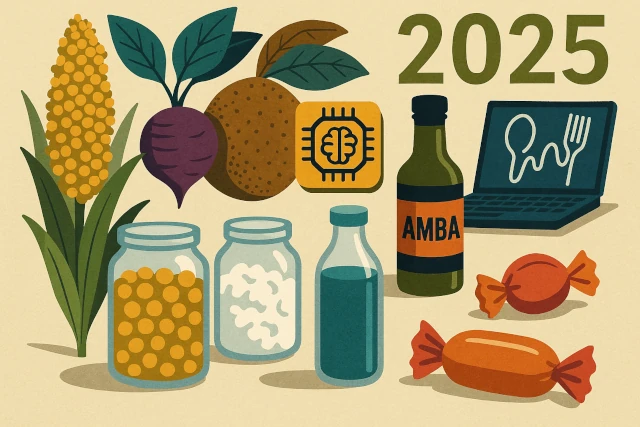Top Food Trends in 2025

Introduction: Why Food Trends Matter
Food trends are not just seasonal fads or social media buzzwords—they are signals of broader consumer behavior shifts, global supply chain dynamics, technological innovation, and cultural change. As someone who has built multiple CPG brands over the past two decades, I've learned that spotting and acting on the right food trend early is often the difference between a breakout brand and a forgettable SKU.
In 2025, we’re seeing a fascinating collision of consumer expectations: they want hyper-personalized nutrition, global flavors, sustainability, and convenience—all at once. The winners will be the brands that ride these waves without losing sight of taste, storytelling, and authenticity.
Here are the five biggest food trends I believe will define 2025—and the next wave of successful CPG innovation.
1. Climate-Resilient Crops & Ingredients
With climate change accelerating, consumers and brands alike are turning to ingredients that can survive drought, heat, and unpredictable weather. Think millet, sorghum, fonio, teff, breadfruit, and moringa. These aren’t just resilient—they’re also nutrient-dense, gluten-free, and rich in culinary history.
Brands like Yolélé (focused on fonio) and Kuli Kuli (pioneering moringa) are already building strong followings. Expect more CPG launches featuring these supergrains—especially in snacks, cereals, and baking mixes.
Why it matters: As food security becomes a global issue, both consumers and retailers are seeking out sustainable alternatives to conventional grains and crops. This isn’t about niche appeal anymore—it’s becoming an imperative.
2. AI-Generated Flavors & Personalization
Artificial intelligence is moving beyond supply chain optimization—it’s now directly influencing flavor development and personalized product formulation. Companies like NotCo are using proprietary AI platforms (like their "Giuseppe" algorithm) to reverse-engineer animal-based products using plants. Meanwhile, tools like FlavorPrint are offering personalized flavor recommendations based on consumer taste profiles.
In 2025, we’re seeing more startups use AI to craft next-gen energy drinks, protein blends, and even adaptogen lattes tailored to biometric or lifestyle data.
Why it matters: Personalization is no longer a luxury—it’s an expectation. AI enables brands to go from mass appeal to microtargeting with hyper-efficiency, unlocking entirely new levels of product-market fit.
3. The Post-Animal Dairy Revolution
Plant-based milk was just the beginning. Now, a new wave of dairy is being made without animals—but with real dairy proteins. Companies like Perfect Day and Remilk are using precision fermentation to produce whey and casein proteins that are bio-identical to those in cow’s milk, without the cow.
This means real dairy ice cream, cheese, and yogurt—minus the ethical, environmental, or lactose concerns. In 2025, expect these products to go mainstream, especially in foodservice and QSR partnerships.
Why it matters: The dairy aisle is undergoing its most radical transformation in a century. Precision-fermented dairy offers the sensory experience of animal dairy with a fraction of the carbon and water footprint.
4. Functional Sweets & Confectionery
Sugar is no longer the villain—it’s the medium. In 2025, the candy aisle is going through a glow-up. We’re seeing confections packed with collagen, magnesium, CBD, L-theanine, and adaptogens. The rise of “candyceuticals” blends indulgence with function.
Look at brands like Ollipop (prebiotic soda), or Sourse (functional vitamin-infused chocolate bites). These are paving the way for gummies, lollipops, and hard candy that support mood, digestion, and immunity.
Why it matters: Consumers want health support—but not always through pills and powders. Sweets are becoming the new supplement delivery system.
5. Hyper-Regional Global Cuisines
Global flavors have always influenced food trends, but 2025 marks a shift to the hyper-regional. Consumers want to taste not just “Indian” or “Mexican” food—but dishes from Kerala or Oaxaca. This is driven by social media micro-influencers, food travel creators, and a growing Gen Z curiosity for authenticity.
CPG brands are responding by spotlighting specific ingredients like uogashi miso, amba sauce, berbere spice, ajvar, kokum, or calamansi. Expect more storytelling-driven packaging that educates consumers while transporting them.
Brands like Fly By Jing (Chengdu flavors) and Diaspora Co. (single-origin Indian spices) are leading the way.
Why it matters: Consumers are using food to travel, explore identity, and connect with cultures. The brands that respect and elevate those origins—rather than dilute them—are earning long-term trust.
Final Thoughts: The Future is Delicious (and Fast)
As we enter the second half of the 2020s, food brands that can anticipate cultural, environmental, and technological shifts will be the ones that thrive. The five trends above aren’t isolated—they're overlapping and accelerating.
If you’re a food entrepreneur, product developer, or investor, now is the time to lean into these signals. The market is hungry—not just for new flavors, but for products with meaning, function, and vision.
Let’s build the future of food—one delicious, purpose-driven bite at a time.







